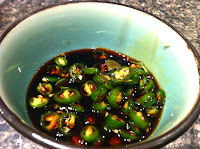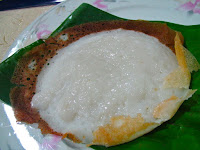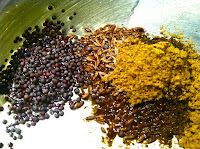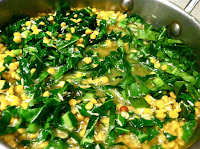![]()
I've been craving this dish since we were home in Malaysia a few weeks ago. In my little hometown of Seremban, there's a spot we fondly call The Square - a municipal parking lot by day, by 6:30pm every day hawker stalls complete with rickety tables and stools fill the area with the incredible sights, sounds and smells of a vibrant Malaysian street food center. There are between twenty and thirty separate food vendors, each boasting a distinct specialty - the offerings range from poh piah and char kuey teow to Hokkien noodles and yam cakes.
Some of these vendors have been selling the same dish here for more than 30 years. A good example is the poh piah lady - I remember eating that dish from her stall from way back when I was a little girl. I have no idea how old she is now, but the last time we were home we found that she no longer works at her famous poh piah stall - her son and daughter-in-law have inherited the business. I was a little sad to not see her familiar face behind the glass case of her stall, but happy that her food legacy continues with the next generation. Her poh piah is truly the best I have ever tasted - nothing, not even the famed poh piah of good ol' days Gurney Drive in Penang tops this. We'll explore this some more in another blog post, but for now let's get back to the loh see fun!
One fateful night last December, we decided to venture to The Square to pay our respects at the shrines of all our favorite food stalls. I had loh see fun on the brain. We arrived there and alas! the loh see fun man was NOT THERE!!! I was devastated and had to appease myself with two plates of char kuey teow to make up for it.
Needless to say, loh see fun has been in my dreams since then. Here we are back in Brooklyn and I haven't been able to stop thinking about it. Nothing to do but make my own! Yesterday, dressed for the freezing cold and determined to tame my vicious cravings for loh see fun, I trekked to Chinatown in Manhattan to find all the necessary ingredients. The cold air felt like shards of glass in my tropics-bred lungs - nothing would stop me. It was definitely worth the effort.
Here's the recipe and some pics - I hope you'll try this at home. It really is quite easy. Dear Loh See Fun Hawker at The Square - please be there the next time we are home. Shall I send you a telegram as soon as we book our flights?
Loh See Fun (serves 6) aka Rat's Tail Noodles (oh, did I not mention that before? :o)
2 tablespoons vegetable oil
4 cloves garlic - minced
1-inch piece of ginger - minced
1 lb ground meat (chicken or pork)
5 dried black mushrooms - soaked in hot water for 6 hours or overnight, then sliced
1 1/2 lbs loh see fun noodles (fresh or frozen)
2 cups fresh beansprouts
2 scallions - sliced for garnish
For the sauce:
Light soy sauce
Dark soy sauce
Sweet soy sauce
Fish sauce
Vegetable or peanut oil
Sesame oil
White pepper
Bring a large pot of water to boil - you will use this to soften the noodles when you are ready to assemble the servings.

Heat the oil in a wok. Add the garlic and ginger and sauté until fragrant. Add the minced chicken or pork (the Seremban hawker version uses pork but I used chicken because the husband does not eat pork) and sliced mushrooms and stir well to combine. Season with one tablespoon of dark soy sauce and a dash of white pepper. Too much dark soy sauce leaves you with a very dark and salty cooked meat, so watch out for that. Add two tablespoons of water to create a little gravy and let this mixture cook for about 10 minutes, stirring ocassionally to make sure the meat is cooked through. Once cooked, transfer from wok into a bowl. Now you're ready to assemble the loh see fun in individual bowls for each person.

Splash the following into serving bowls: 1 tsp dark soy sauce, 1/2 tsp light soy sauce, 1/2 tsp sweet soy sauce, 1/4 teaspoon fish sauce, 1/4 teaspoon vegetable oil, 1/4 teaspoon sesame oil, and a generous dash of white pepper. I felt compelled to list these amounts just to give you an idea how little of each sauce you actually need. Also, be careful with the fish sauce and the oils - a little really does go a long way. My advice would be to experiment with one serving - give it a taste and decide if you'd like a little less soy sauce, a little more sesame oil and so on. Honestly, I never measure these amounts. Neither does my beloved absentee loh see fun hawker in Seremban. I've watched him do it a thousand times and it's just a splash of this and a splash of that. He artfully swirls it around the sides of the bowls - you'll see from my picture that I failed at the swirl. All my sauce ended up at the bottom of the bowl - ok, so I lack the flair and flourish!

Add a handful of raw beansprouts to each bowl.
Put a handful of noodles in a Chinese-style basket colander and immerse in that pot of boiling water - let this sit for about 20 - 30 seconds to soften up those noodles. Drain and add the noodles to the bowls, over the beansprouts. The heat from the noodles will blanch those beansprouts to perfection. There's nothing worse than soggy, overcooked beansprouts. These will remain crunchy and add incredible texture to this dish. Now spoon some of the chicken/mushroom mixture over those beautiful noodles and garnish with some sliced scallions. Ta-dah! LOH SEE FUN! The noodles have a really nice bite to them, the beansprouts are crunchy, the combination of sauces is easy to master with a few tries and unbelievably tasty for how easy it is.
I eat my loh see fun with some chopped up bird eye chillies, marinated in soy sauce. Remember to tell your friends to mix the noodles well as all that delicious sauce is at the bottom of those bowls. Thank you loh see fun hawker for the inspiration. You're a legend in my mind!


 2 tsp curry powder
2 tsp curry powder Put all the ingredients for the sauce in a blender. Blend well. Spread generously over the fish, making sure to cover the sides as well and reserving just a little bit of the sauce. Lay two pieces of sliced tomato on each steak, and spread with the remaining sauce. Sprinkle the chopped cilantro over the dressed fish and now it's time to party!
Put all the ingredients for the sauce in a blender. Blend well. Spread generously over the fish, making sure to cover the sides as well and reserving just a little bit of the sauce. Lay two pieces of sliced tomato on each steak, and spread with the remaining sauce. Sprinkle the chopped cilantro over the dressed fish and now it's time to party! Cover the fish with the second piece of parchment and fold the sides of both pieces together, crimping and rolling to form a tight seal. Bake for 20 minutes - the rule of thumb for fish is 15 minutes per inch of thickness for fillets. I added five minutes because these were bone-in steaks. Here's what it looked like when the tray came out of the oven -
Cover the fish with the second piece of parchment and fold the sides of both pieces together, crimping and rolling to form a tight seal. Bake for 20 minutes - the rule of thumb for fish is 15 minutes per inch of thickness for fillets. I added five minutes because these were bone-in steaks. Here's what it looked like when the tray came out of the oven - 


































